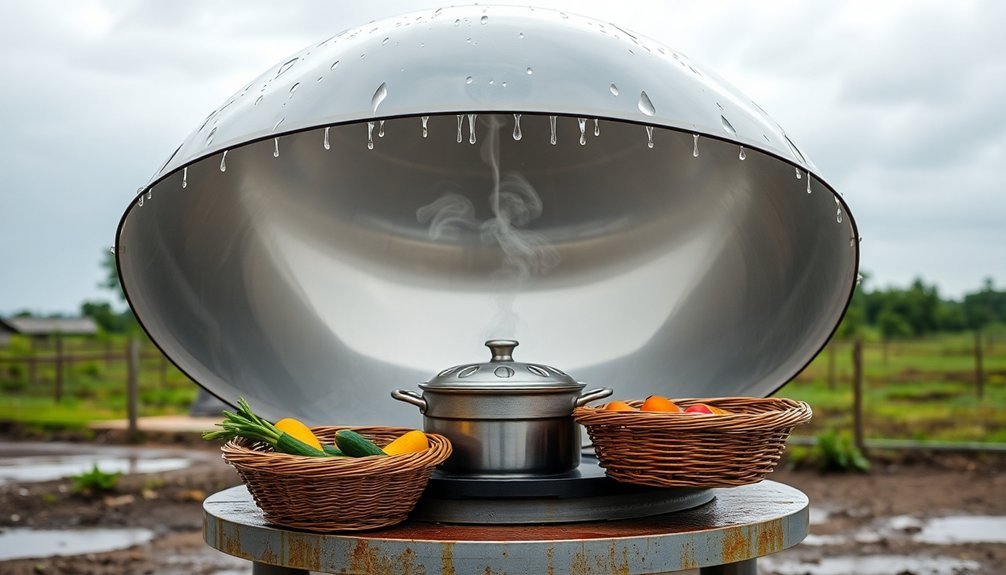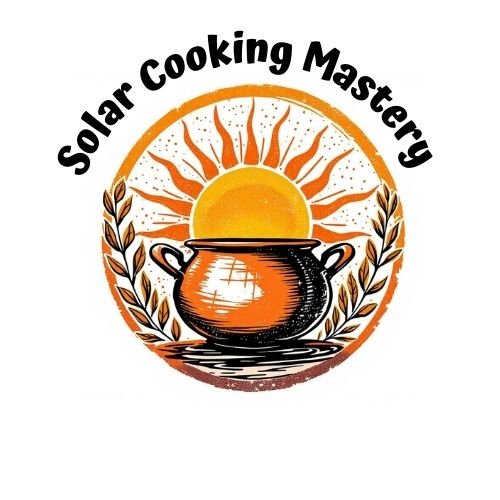During monsoon season, you'll need three reliable methods to prepare meals safely. First, make the most of sunny breaks by pre-cooking proteins and grains, storing them properly below 40°F in airtight containers. Second, maintain a clean solar cooking station by regularly wiping reflectors and keeping the black target surface dust-free for those partially sunny days. Third, set up a well-ventilated indoor cooking space with proper exhaust fans and dehumidifiers to combat moisture when rain prevents outdoor cooking. These strategies will help you maintain food safety and cooking efficiency, but there's much more to monsoon meal preparation than meets the eye.
Clean Solar Cooking Station

While monsoon season presents unique challenges for solar cooking, maintaining a clean cooking station is essential for top performance. High thin clouds can significantly reduce cooking efficiency, making cleanliness even more critical.
You'll need to verify your black target surface remains free of dust and debris to maximize sunlight absorption. Keep your reflectors polished and properly positioned to direct maximum sunlight onto your cooking vessel.
Clean your glass or plastic heat trap regularly, as any dirt or smudges can reduce the amount of sunlight reaching your food.
Your matte black cooking vessel should be spotless before each use to maintain peak heat absorption.
Don't forget to check your insulation materials for moisture damage, especially during humid monsoon conditions.
When you're not using the cooker, store it in a dry place to prevent mold growth and maintain its efficiency for those precious sunny moments.
Alternate Indoor Methods
When monsoon rains make solar cooking impossible, you'll need reliable indoor cooking alternatives to prepare meals safely. Focus on maintaining a dry, well-ventilated cooking space to prevent moisture buildup. Regular exhaust fan use during meal preparation helps control humidity levels and removes excess moisture from your kitchen.
Keep your countertops and utensils thoroughly dried after each use, and store your cooking tools in airtight containers to protect them from humidity.
You'll want to pay special attention to your food storage during this time. Use sealed containers and place them in areas with good air circulation. Check your ingredients regularly for signs of mold, and don't hesitate to discard anything suspicious.
If you're using electric appliances, make sure they're placed away from wet areas, and always dry your hands before handling them. Consider using a dehumidifier to maintain ideal moisture levels in your kitchen space.
Pre-Cook During Sunny Breaks

During sunny intervals in the monsoon season, you'll need to take advantage of these precious breaks to pre-cook your meals. Focus on preparing proteins and grains first, as these form the foundation of most dishes. You can also make base ingredients like sauces and soups during this time.
When pre-cooking, remember to maintain strict food safety standards. Always wash your hands thoroughly and use separate cutting boards for vegetables and raw meats. Cook all food to safe internal temperatures and store it promptly in airtight containers in your refrigerator below 40 degrees F. Consider incorporating local seasonal ingredients like ragi, coconut, and lentils into your meal preparation.
Don't forget to label and date everything you store.
When it's time to eat, verify you reheat pre-cooked food to at least 165 degrees F for safe consumption. This preparation strategy helps you maintain food security during unpredictable monsoon weather.
Frequently Asked Questions
How Long Can Cooked Food Safely Stay at Room Temperature During Monsoons?
You shouldn't leave cooked food at room temperature for more than two hours during monsoons. After that, it'll enter the danger zone (5°C-60°C), where bacteria multiply rapidly, risking foodborne illness.
Which Traditional Indian Spices Help Preserve Food Naturally During Rainy Season?
You'll find that turmeric, ginger, cloves, black pepper, and ajwain are excellent natural preservatives. They'll help keep your food fresh during monsoons thanks to their antimicrobial and antioxidant properties.
Can Pressure Cooking Eliminate Harmful Bacteria Better Than Regular Cooking Methods?
Yes, you'll find pressure cooking more effective at eliminating harmful bacteria than regular cooking methods. It achieves higher temperatures under pressure and kills bacteria faster, while retaining more nutrients in your food.
Are Electric Rice Cookers Safer Than Gas Stoves During Heavy Rain?
Yes, you'll find electric rice cookers safer than gas stoves during heavy rain. They don't have open flames, include automatic shut-off features, and won't pose gas leak risks that could worsen in wet conditions.
What's the Best Way to Store Leftover Curry During Monsoon Season?
You'll want to store your leftover curry in airtight containers and refrigerate it immediately after cooling. Don't leave it at room temperature, and use small portions so you're not repeatedly reheating the same batch.
In Summary
You'll stay nourished during monsoon season by implementing these three practical cooking methods. Whether you're maintaining a clean solar station, utilizing indoor alternatives, or taking advantage of sunny breaks to pre-cook meals, you've got options to keep your kitchen running smoothly. Don't let heavy rains disrupt your cooking routine – with proper planning and these strategies, you'll continue preparing healthy meals regardless of the weather.





Leave a Reply